The next-gen MacBook Pro with Retina Display Review
by Anand Lal Shimpi on June 23, 2012 4:14 AM EST- Posted in
- Mac
- Apple
- MacBook Pro
- Laptops
- Notebooks
Last year when I wrote about the new MacBook Airs I offered two forward looking paragraphs:
What happens from here on out is what's really interesting. Intel has already committed to moving the TDP of its mainstream parts from 35W - 45W down to 10 - 20W. Since the Air is the new mainstream Mac notebook, Apple has already made that move. The performance in this 10 - 20W segment is going to get much better over the next two years, particularly once Haswell arrives.
The Thunderbolt Display is the first sign of what's to come. Moving IO controllers and expansion into the display, and potentially even moving discrete GPUs out of the notebook are all in store for us. Apple is really ahead of the curve here, but it's easy to imagine a future where laptops become a lot more like the new Air and shift to a couple high bandwidth ports instead of numerous lower bandwidth connections.
Perhaps I was being too aggressive in the prediction of a couple of high bandwidth ports. After all, the next-generation MacBook Pro with Retina Display features four such IO ports (2 x Thunderbolt and 2 x USB 3.0). But you get my point. Gigabit Ethernet and Firewire 800 are both gone. The discrete GPU is still present but I suspect even its days are numbered, at least inside the chassis. The personal computer as we knew it for so long, is changing.
The personal computer is getting thinner, lighter, more integrated and more appliance-like. The movement is no longer confined to just Apple either. The traditional PC OEMs are following suit. Even Microsoft has finally entered the PC hardware business, something it threatened to do for years but hadn't until now. Distribution models will change, the lines between different form factors will continue to blur. What was once a mature industry is going through a significant transformation. It’s exciting but at the same time it makes me uneasy. When I first got into this industry everyone had stories of companies with great ideas that just didn’t make it. As we go through this revolution in computing I’m beginning to see, first hand, the very same.
Apple makes the bulk of its revenue from devices that don’t look like traditional personal computers. For the past couple of years I’ve been worried that it would wake up and decide the traditional Mac is a burden, and it should instead be in the business of strictly selling consumer devices. With its announcements two weeks ago in San Francisco, I can happily say that my fears haven’t come true. At least not yet.
It’s been a while since Apple did a really exciting MacBook Pro launch. Much to my surprise, even the move to Sandy Bridge, the first quad-core in a MacBook Pro, was done without even whispers of a press conference. Apple threw up the new products on its online store, shipped inventory to its retail outlets, updated the website and called it a day. Every iPhone and iPad announcement however was accompanied with much fanfare. The MacBook Pro seemed almost forgotten.
With its WWDC unveil however Apple took something that it had resigned to unexciting, dare I say uncool status, and made a huge deal about it. Two weeks ago Apple did the expected and offered relatively modest upgrades to all of its portable Macs, all while introducing something bold.
Apple calls it the MacBook Pro with Retina Display. You’ll see me refer to it as the next-gen MacBook Pro, Retina MacBook Pro, rMBP or some other permutation of these words.
After using it for the past two weeks I can honestly say it’s the best Mac Apple has ever built. And there’s a lot more to it than hardware.
Portability
If you were hoping for a 15-inch MacBook Air, that’s not what the rMBP is. Instead it is a far more portable 15-inch MacBook Pro. I have to admit I was a bit let down the first time I laid eyes on the next-gen MacBook Pro, it looks good but it doesn’t look all that different. The disappointment quickly faded as I actually picked up the machine and started carrying it around. It’s not ultra light, but man does it make the previous chassis feel dated.
While I never really liked lugging around the old MBP (and it always made me feel like the old fogey at tradeshows where everyone else had something 13-inches or smaller), carrying the rMBP is a pleasure by comparison. Pictures really don’t do it justice. The impressively thin display assembly or overall chassis thickness look neat in a photo but it’s not until you actually live with the rMBP that you can appreciate what Apple has done here. I carry around a 15-inch MacBook Pro because it’s my desktop, and as such it’s incredibly useful to have with me when I travel. For my personal usage model, the Retina MacBook Pro is perfect.
If your workload demands that you need the performance of a MacBook Pro and your lifestyle requires you to carry it around a lot, the reduction in thickness and weight alone will be worth the upgrade to the rMBP. If you spend most of your time stationary however, you’ll have to be sold on the display and internal characteristics alone. The bad news is if the design doesn’t get you, everything else will.

From left to right: 11-inch MacBook Air, 13-inch MacBook Air, 15-inch MacBook Pro, MacBook Pro with Retina Display
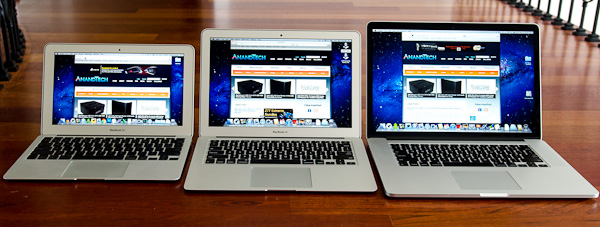
From left to right: 11-inch MacBook Air, 13-inch MacBook Air, MacBook Pro with Retina Display
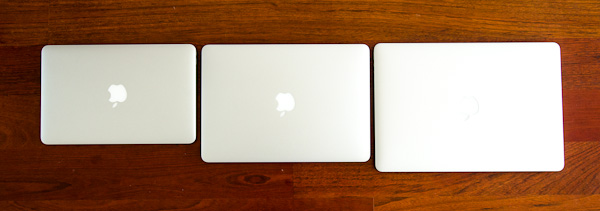
From left to right: 11-inch MacBook Air, 13-inch MacBook Air, MacBook Pro with Retina Display


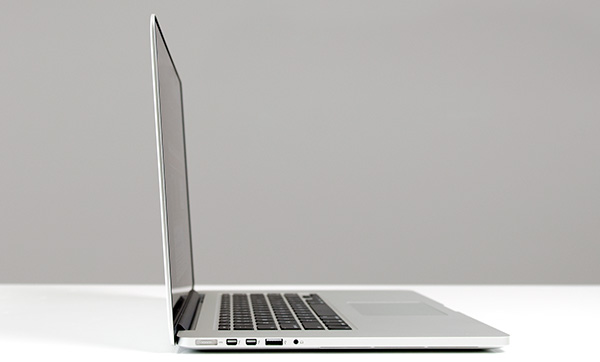
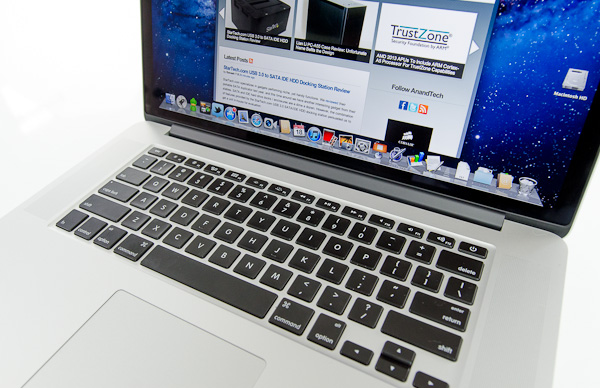
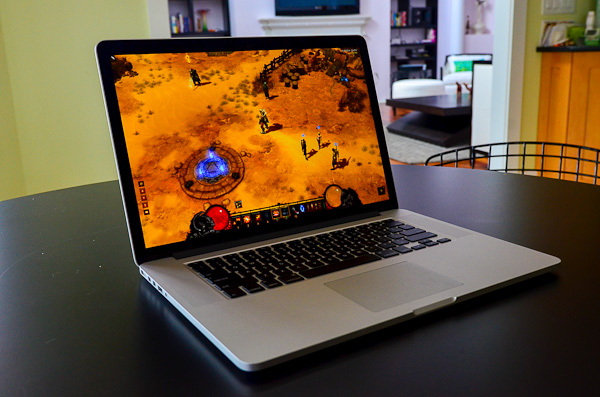
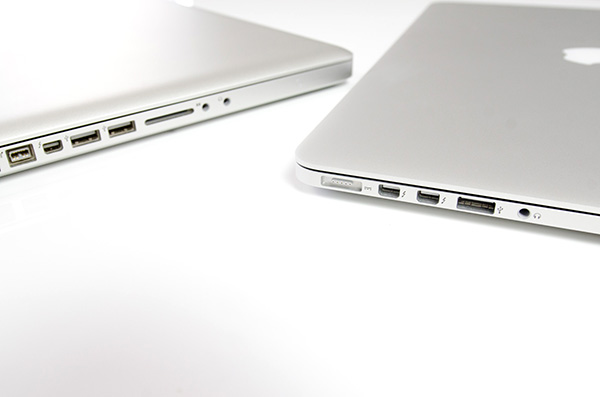
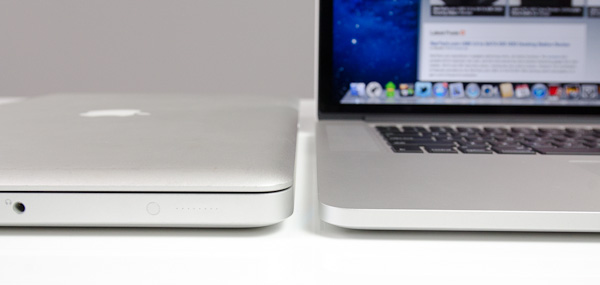








471 Comments
View All Comments
vincbxart - Saturday, June 23, 2012 - link
u wrong. Because of :16x9 is good to show my video work.
Discrete GPU is for gaming, ivy bridge is powerfull enough to threat with 4k video
VGA is especially for professionnal, a lot of video projector till get that.
The weight doesn't determine consumer or creative laptop...
Why the Z is not a consumer laptop
The price - pricier than the mb
The gamut full adobe rvb when apple is bader than the mb 2008... (98% VS 68%...) - you pay a lot for it
btw both are good. But The Z was greater than the macbook retina 2008 vs 2012
dannyboy153 - Sunday, June 24, 2012 - link
1) Showing of your video work is consuming media not creating. Feel free the use whatever you want to create content but I find it easier to do it on a 16x10. Menu bars, navigation panels, etc takes up room.2) I'm comparing the Sony Z to the MBP, not some technical fact that Ivy Bridge can do this or that. Does the Z output 2560x1600? No.
3) I didn't say the weight determine what was consumer or creative.
4) You can use the Z for creating content. You can use a $400 laptop to create content. But clearly the former is better than the later. Same with the MBP with retina vs the Z...clearly the former is better than the later. But use whichever one you want.
danrhiggins - Saturday, June 30, 2012 - link
BTW, I have a 2010 Z with 2 docking stations and the extra battery (the big one) that has been sitting on my desk unused for nearly a year when I switched to a 2011 MacBook Air. I really liked the Z. It was smaller and lighter than the Air. Actually I found the screen a bit too short for me.Bottom line is that I fell in love with the Mac OS and gestures. But that is just me.
So if anyone lives in Colorado and is interested I am going to put the Z on Craigslist. ;-)
KoolAidMan1 - Saturday, June 23, 2012 - link
Nailed it, the small 16:9 display, thicker chassis, and no dedicated GPU are huge corners that were cut. One can barely compare it with other 13" notebooks, let alone the 15" rMBP.Lots of grasping for straws going on here....
OCedHrt - Sunday, June 24, 2012 - link
Thicker chassis? The z is thinner than the MBP.The 13" is a design choice, not a manufacturing limitation. The goal is a 2.5 laptop. Japanese people don't weigh 180 lbs and don't like slugging around 4.5 lb laptops.
Barely compare it with other 13" notebooks? Care to list one that can even compete? It was 80% of the MBP retina in an MBA form factor in 2008, and then even lighter in 2011.
Spunjji - Monday, June 25, 2012 - link
Don't bother, you're arguing with an ignoramus.Chava - Friday, June 29, 2012 - link
+1KoolAidMan1 - Friday, July 6, 2012 - link
The only ignoramus I see are people grasping at straws trying to say that the rMBP has already been done in other laptops before.Sad and desperate
Spunjji - Thursday, November 8, 2012 - link
Thanks for proving my point.Guspaz - Saturday, June 23, 2012 - link
I tried out a Vaio Z in a Sony store when I was in the market for an ultraportable laptop (I decided on the first-gen Toshiba Portégé ultraportable, something I somewhat regret). The Vaoi Z was impressively thin, but suffered from three fatal flaws:1) Ludicrously expensive. The base model was $2000, and you needed to upgrade it a bunch from there to get the specs respectable
2) Only shipped with a bilingual keyboard; Sony refused to ship an American keyboard in Canada, even online, forcing consumers to get a strange non-standard keyboard with a funny shaped enter key
2) Indrecibly delicate. If you poke the screen in the corner with one finger, the whole screen flexes and bends away from your finger. It felt like this thing would shatter if I breathed on it.
In the end, it was no lighter than the Toshiba, and cost almost a thousand dollars more, but the Toshiba had its own issues.